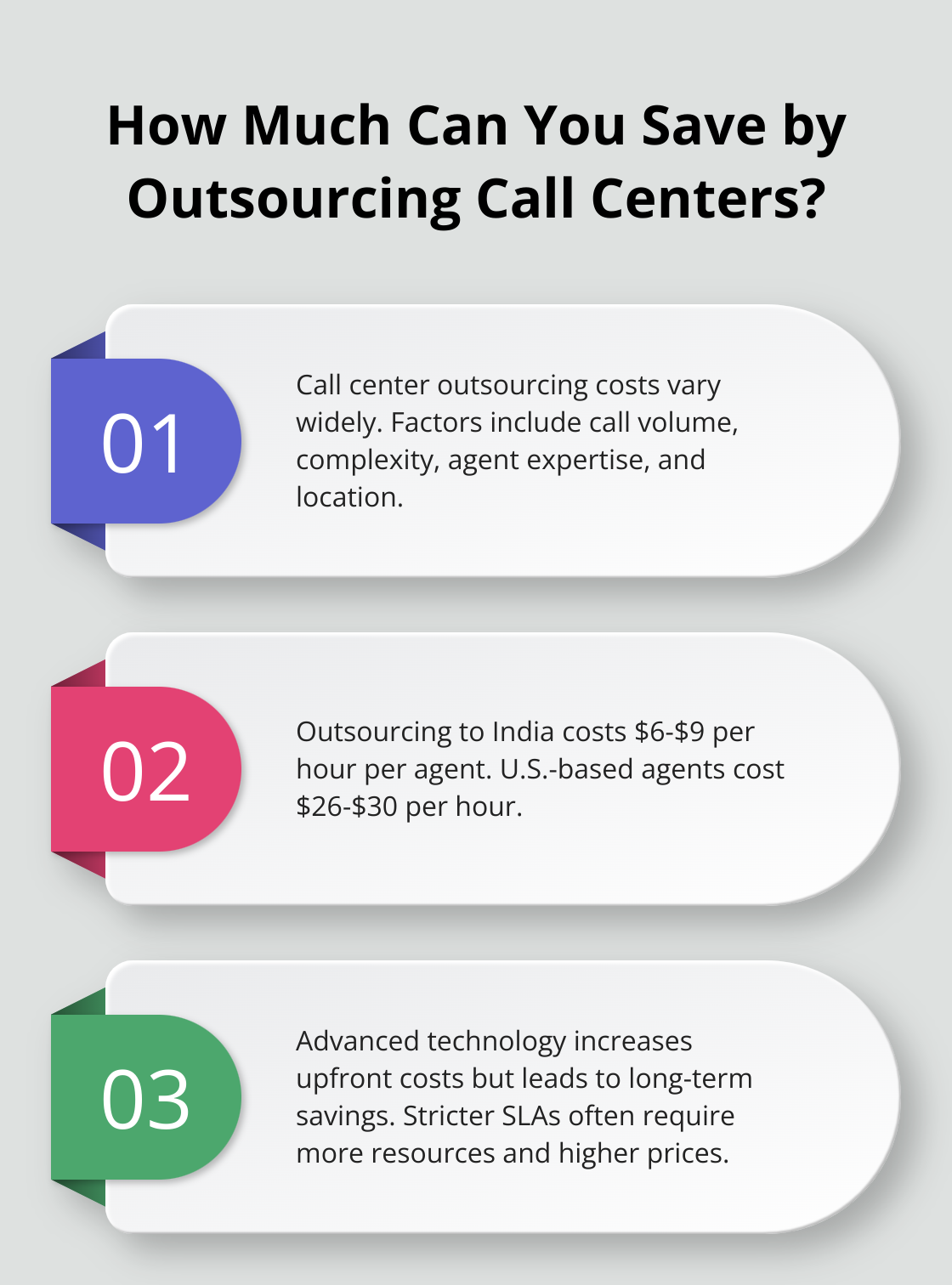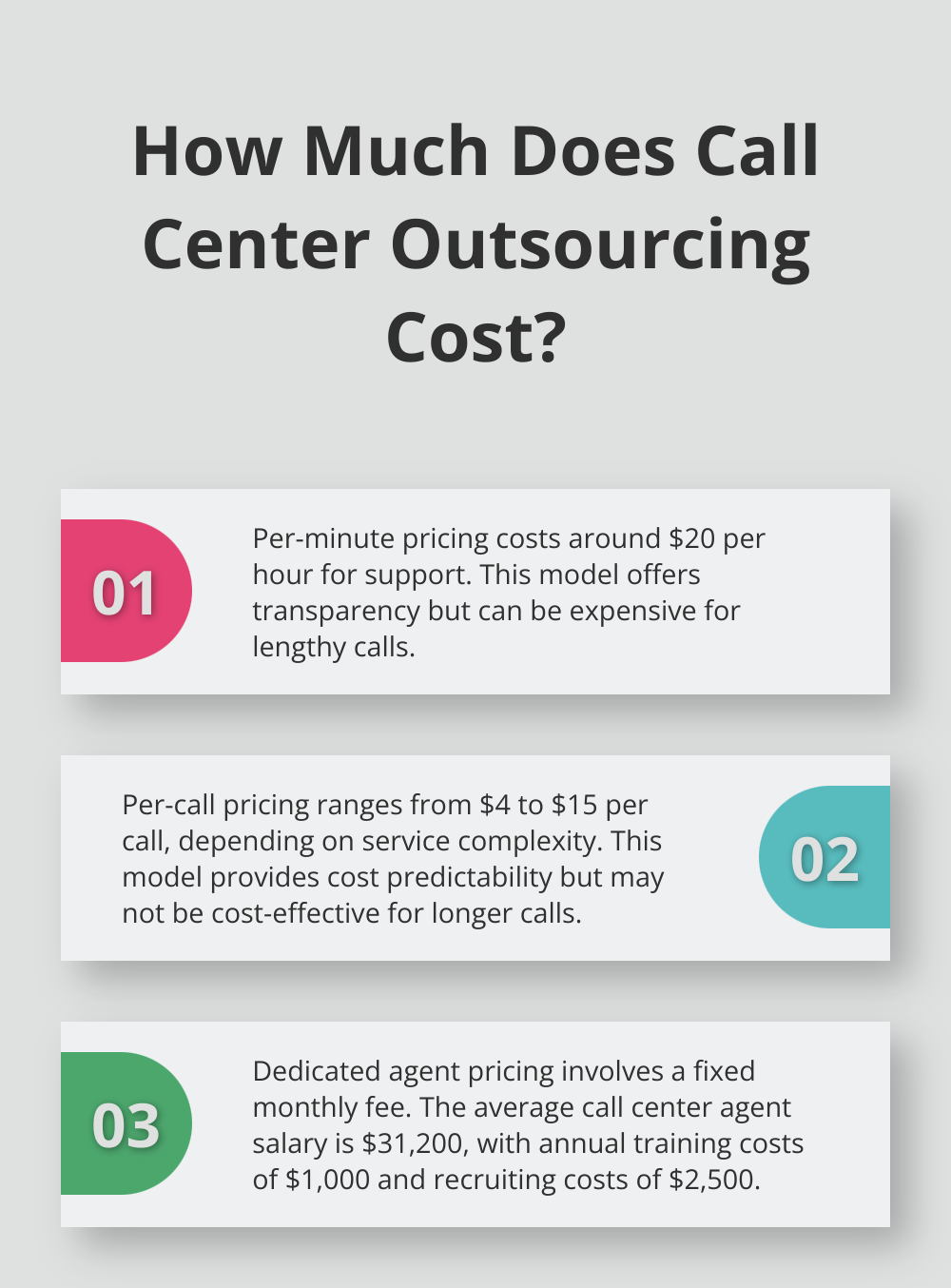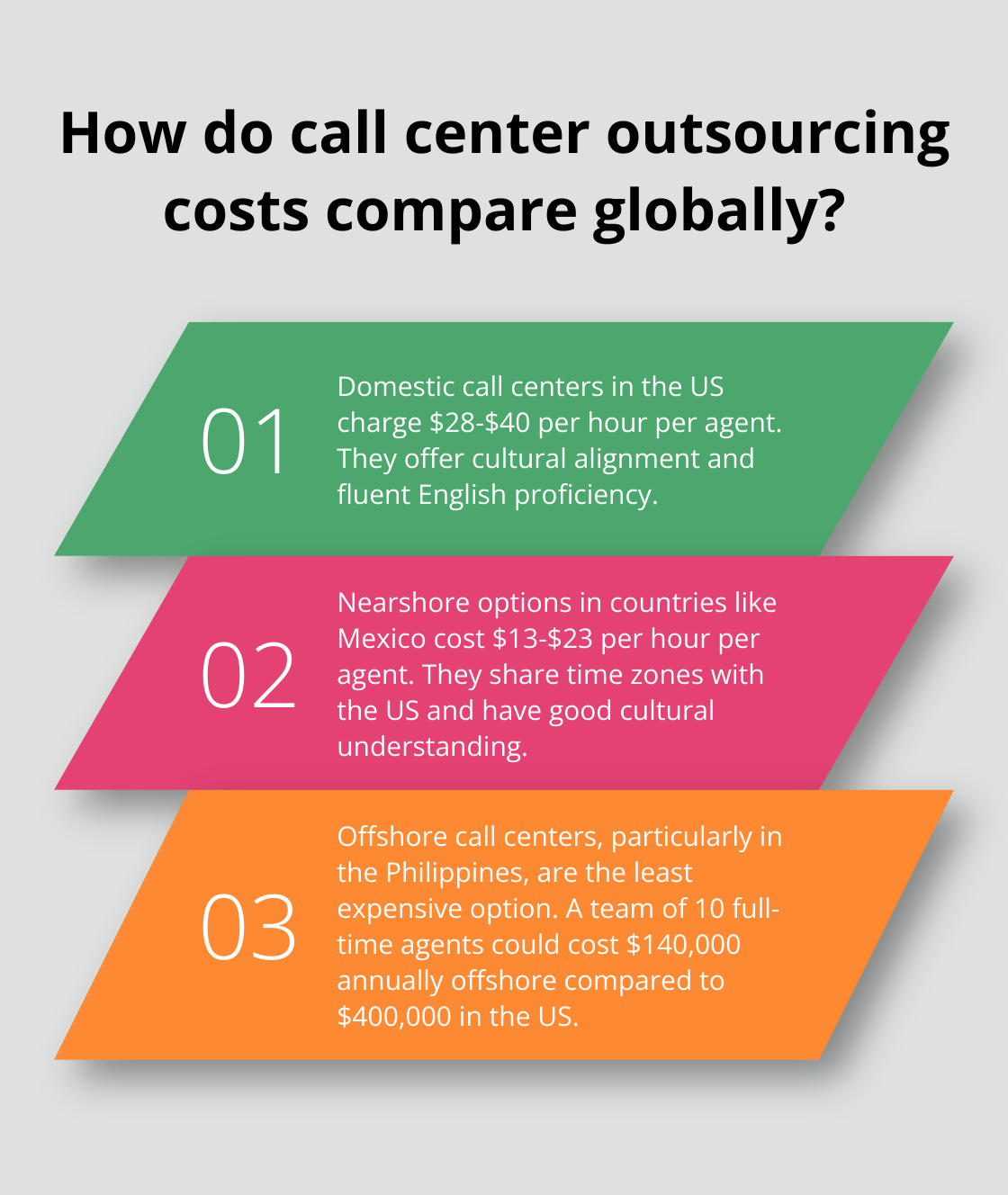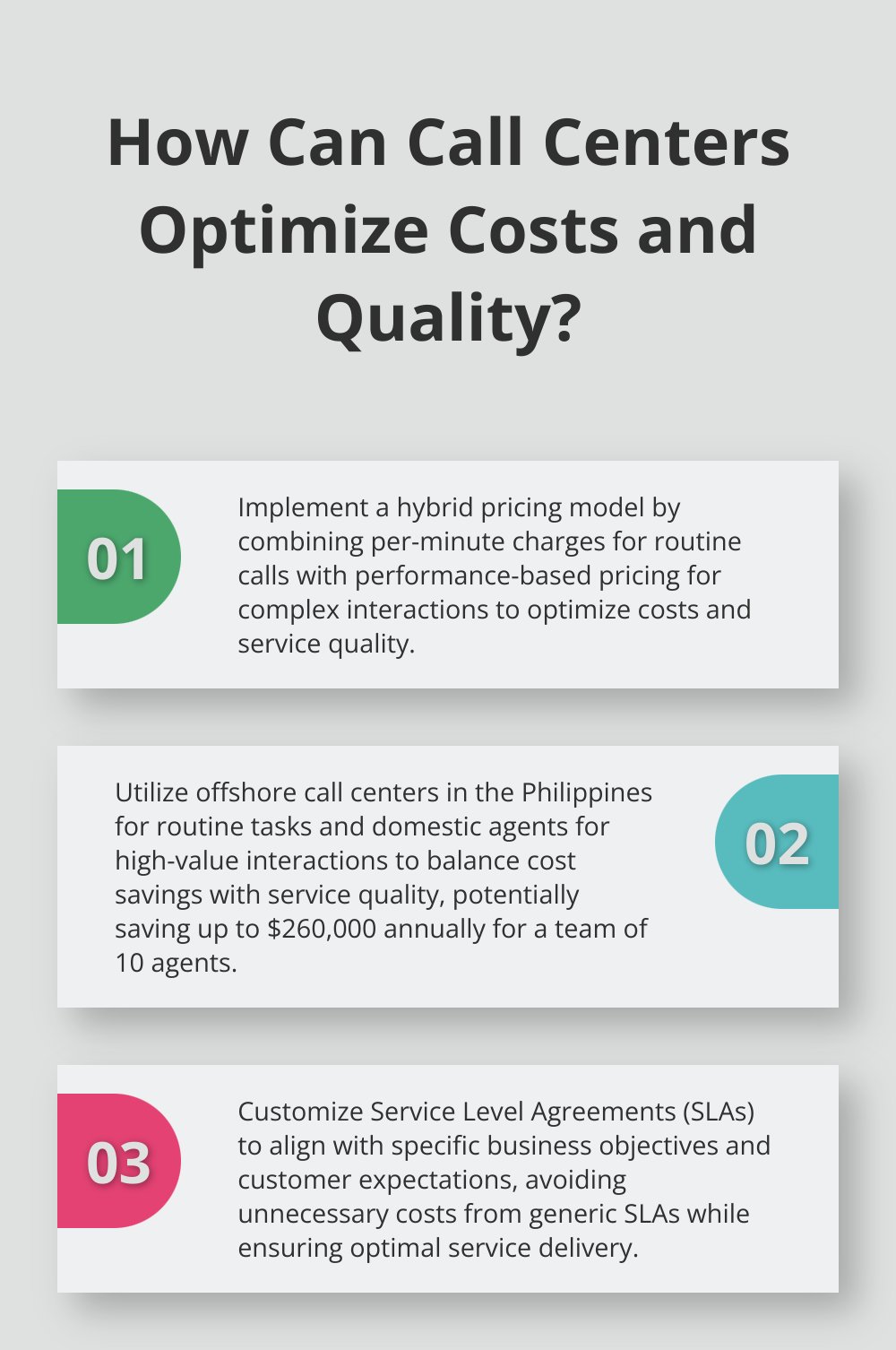Outsourcing a call center can significantly impact your business’s bottom line. But how much does it really cost?
At Outsource Consultants, we’ve seen firsthand how call center pricing varies widely based on several key factors. This post breaks down the costs, pricing models, and outsourcing options available to help you make an informed decision.
What Drives Call Center Outsourcing Costs?
Call center outsourcing costs depend on multiple variables. Understanding these factors helps businesses make strategic outsourcing decisions that optimize budget and service quality.
1. Call Volume and Complexity
The number and nature of customer interactions significantly impact costs:
- High call volumes can lower per-interaction costs due to economies of scale.
- Complex inquiries requiring longer handling times or specialized knowledge (e.g., technical support) increase expenses.
2. Agent Expertise and Location
Agent skill level and geographic location play a crucial role in pricing:
- Entry-level agents handling simple tasks cost less than experienced professionals managing complex issues.
- Geographic impact: Forbes Advisor reports that outsourcing to India costs $6 to $9 per hour per agent , while U.S.-based agents may cost $26 to $30 per hour.
3. Technology and Infrastructure
Advanced technology can lead to long-term savings but requires initial investment:
- Cloud-based solutions and AI-powered tools improve efficiency.
- CRM systems enhance agent productivity and customer satisfaction.
4. Service Level Agreements (SLAs)
SLAs define performance expectations and impact costs:
- Stricter SLAs (shorter wait times, higher first-call resolution rates) require more resources and increase pricing.
- Tailored SLAs help businesses avoid unnecessary costs while maintaining optimal service quality.

5. Pricing Models
Choosing the right pricing model affects overall costs. Options include:
- Per-minute pricing – Best for predictable call durations.
- Per-call pricing – Ideal for short, repetitive inquiries.
- Dedicated agent pricing – Best for businesses requiring consistent support.
- Performance-based pricing – Aligns provider incentives with business goals.
- Hybrid models – Combines elements for flexibility and cost optimization.
Call Center Pricing Models Explained
Understanding different pricing models helps businesses select the most cost-effective option.

1. Per-Minute Pricing
- Charges based on actual talk time.
- Suitable for businesses with consistent call volumes.
- Average cost: $0.35–$0.75 per minute (equating to about $20–$45 per hour).
- Downside: Can be costly during unexpected volume spikes.
2. Per-Call Pricing
- Fixed rate per call, regardless of duration.
- Works well for short, simple interactions.
- Typical cost: $4–$15 per call (varies by complexity).
- Risk: Not ideal for businesses with longer average handle times.
3. Dedicated Agent Pricing
- Fixed monthly fee per full-time agent.
- Ideal for businesses requiring specialized support.
- Estimated costs:
- Agent salary: $31,200 per year
- Training costs: $1,000 per year
- Recruiting costs: $2,500 per year
- Higher cost but ensures brand immersion and specialized service.
4. Performance-Based Pricing
- Fees tied to key performance metrics (customer satisfaction, sales conversions).
- Incentivizes high performance.
- Requires well-defined performance criteria to prevent excessive costs.
5. Hybrid Pricing Models
- Combines elements of different pricing models.
- Offers flexibility to balance cost-efficiency and service quality.
What Are the Cost Ranges for Different Outsourcing Options?
Call center outsourcing costs vary significantly based on location. Understanding these differences helps businesses make informed decisions that balance quality and affordability.
Domestic (Onshore) Call Center Costs
Onshore call centers in the United States typically charge between $28 to $40 per hour for each agent. These centers offer advantages like cultural alignment and fluent English proficiency. Businesses that require nuanced communication or handle sensitive information often prefer domestic options.
- Cost per agent: $28–$40 per hour.
- Advantages: Cultural alignment, native English proficiency, enhanced data security.
- Best for: Companies handling sensitive information or requiring nuanced communication.
Nearshore Call Center Costs
Nearshore options in countries like Mexico or Costa Rica present a middle-ground solution. Costs range from $13 to $23 per hour per agent. These locations often share time zones with the U.S. and have a good grasp of American culture. Nearshore centers suit businesses that seek cost savings without sacrificing too much familiarity.
- Cost per agent: $13–$23 per hour.
- Locations: Mexico, Costa Rica, Colombia
- Benefits: Lower costs than U.S. options, similar time zones, and cultural familiarity.
Offshore Call Center Costs
Offshore call centers are generally less costly to operate due to lower wage expectations and reduced overall cost. The Philippines stands out as a top choice due to its strong English proficiency and cultural affinity with the U.S.
- Cost per agent: $6–$12 per hour.
- Top locations: Philippines, India, South Africa (https://www.outsource-consultants.com/philippines-call-center/).
- Pros: Significant cost savings, large talent pool, English fluency.
- Cons: Time zone differences, cultural barriers, potential quality concerns.
Cost Comparison
The cost differences are stark. A team of 10 full-time agents could cost around $400,000 annually in the U.S., $230,000 in a nearshore location, and only $140,000 offshore. However, these figures don’t account for potential differences in productivity or customer satisfaction.
- U.S. call center (10 agents): ~$400,000 per year.
- Nearshore call center (10 agents): ~$230,000 per year.
- Offshore call center (10 agents): ~$140,000 per year.
Beyond Hourly Rates
Companies should look beyond just the hourly rates. Factors like agent turnover, training costs, and management overhead can significantly impact the total cost of ownership. For instance, offshore centers have lower base costs, but they might require more extensive training or have higher turnover rates (potentially offsetting some savings).

Quality assurance is another critical factor. Domestic centers often have more robust quality control processes, which can lead to higher customer satisfaction. Offshore centers might need additional investment in monitoring and training to maintain similar standards.
Many businesses achieve the best results by adopting a hybrid approach. This strategy involves using domestic agents for complex or high-value interactions while leveraging offshore teams for more routine tasks. This balanced approach optimizes costs while maintaining service quality where it matters most.
The right choice depends on specific business needs, budget constraints, and customer expectations. While cost is an important factor, it shouldn’t be the only consideration. The impact on customer satisfaction, brand perception, and long-term customer loyalty must also factor into the decision-making process.
For organizations looking to reduce costs while improving scalability and customer service, call center outsourcing can be a great solution. However, it’s essential to carefully evaluate all options and their potential impacts before making a decision.
Final Thoughts
Outsource call center pricing depends on various factors such as call volume, agent expertise, and location. The choice of pricing model significantly impacts overall costs, with domestic options typically costing more than nearshore or offshore alternatives. Companies must balance cost reduction with service quality, cultural alignment, and specific business needs to find the most effective solution.

Expert guidance proves valuable when navigating the complexities of call center outsourcing. Outsource Consultants specializes in optimizing call center services and AI technology. Their extensive network of vetted vendors and industry knowledge helps businesses find the right balance between cost-efficiency and service quality.
Informed decisions about call center outsourcing are essential in today’s customer service landscape. Companies that carefully consider all factors and focus on long-term value can transform their customer service operations into a powerful competitive advantage. Outsource Consultants can provide tailored solutions that align with company culture and customer expectations, potentially leading to significant cost savings without compromising performance.
Frequently Asked Questions (FAQs)
- How much does it cost to outsource a call center?
Call center outsourcing costs range from $6 to $40 per hour per agent, depending on location, expertise, and service level. - What is the most cost-effective call center pricing model?
The best model depends on call volume and service complexity. Per-minute pricing works for predictable call durations, while dedicated agents suit businesses needing consistent support. - Is offshore outsourcing always the cheapest option?
Offshore outsourcing offers the lowest hourly rates, but additional costs (training, quality assurance, time zone challenges) may offset some savings. - What are the main risks of outsourcing a call center?
Risks include language barriers, cultural differences, security concerns, and service quality inconsistencies. Choosing the right partner mitigates these risks. - How can I ensure quality while outsourcing?
Establish clear SLAs, invest in training, conduct regular audits, and choose vendors with a strong reputation for service excellence.






